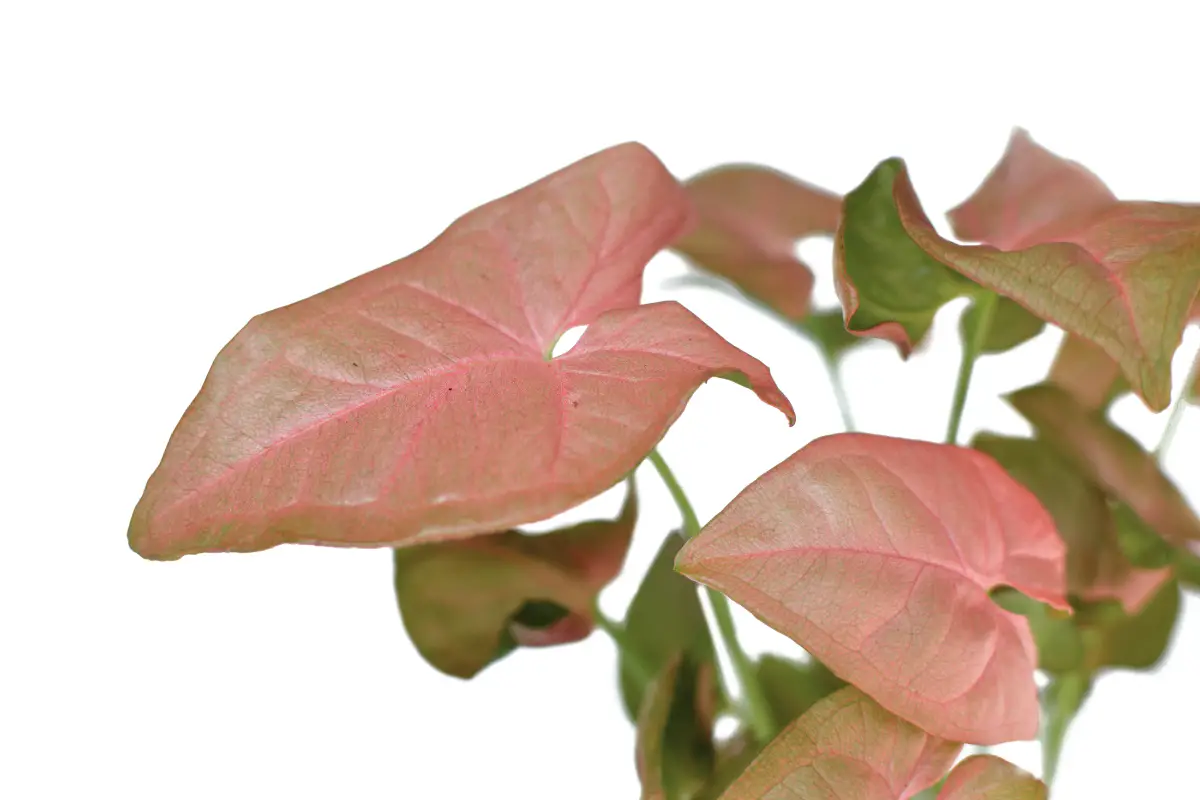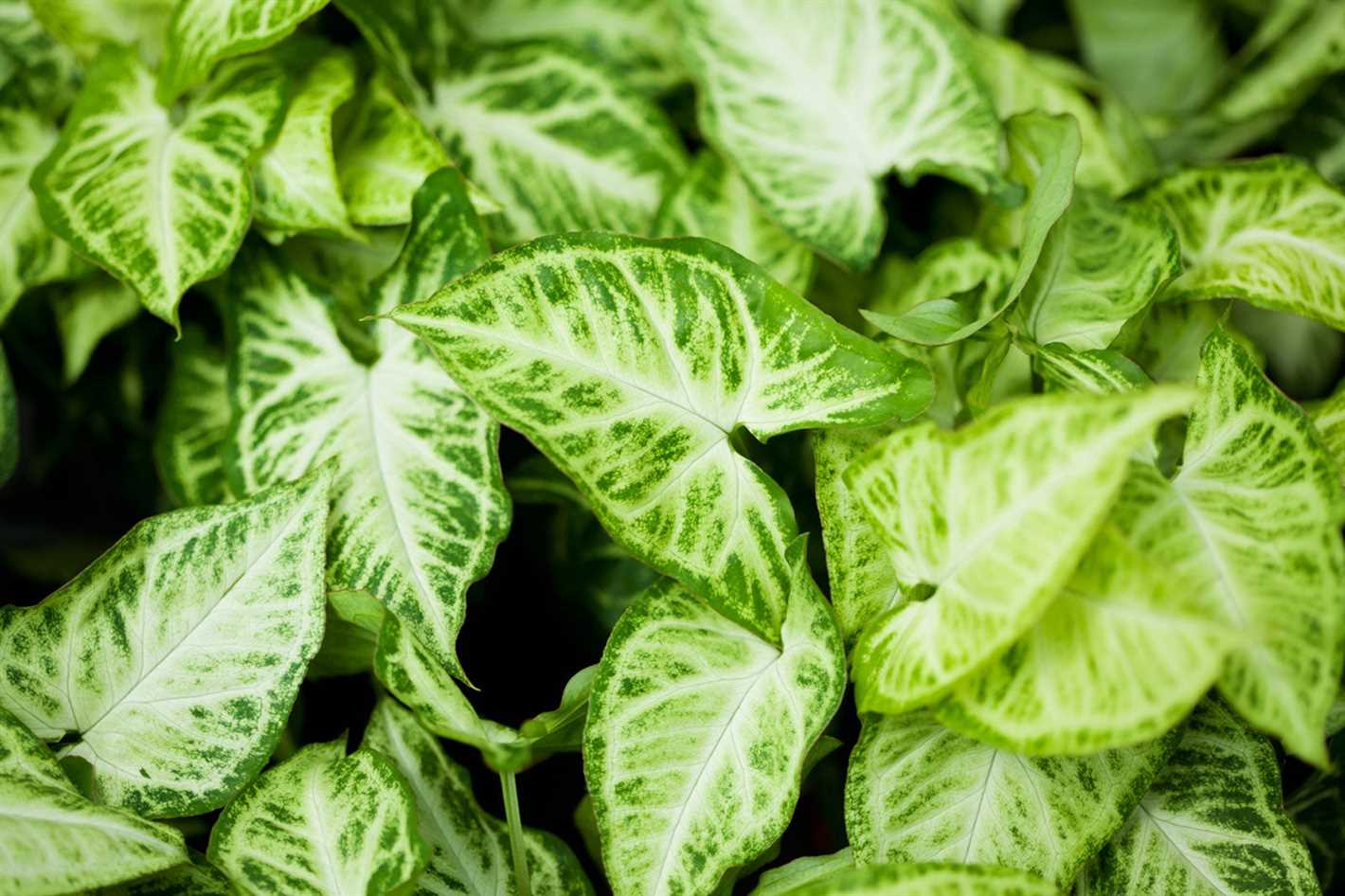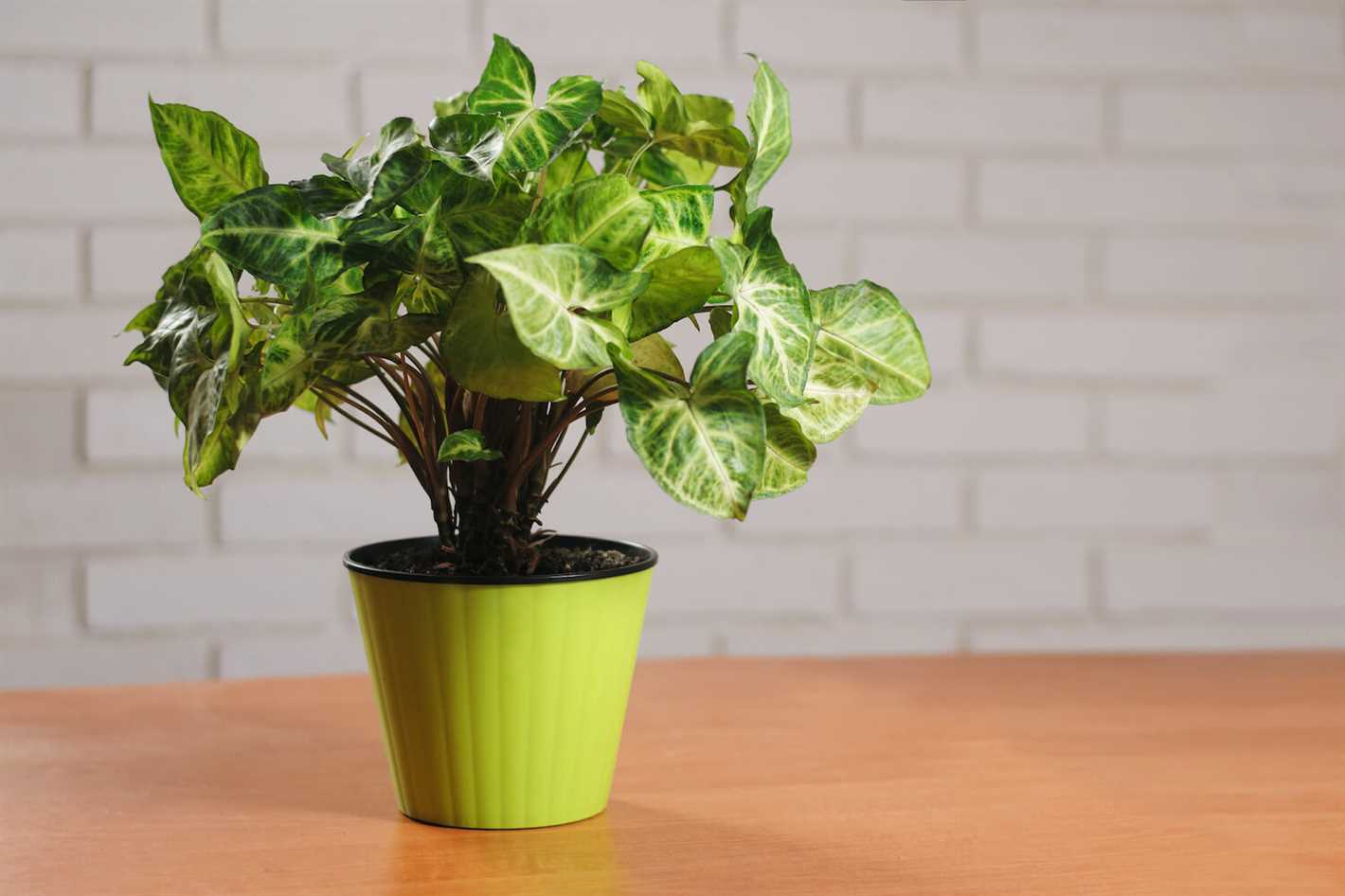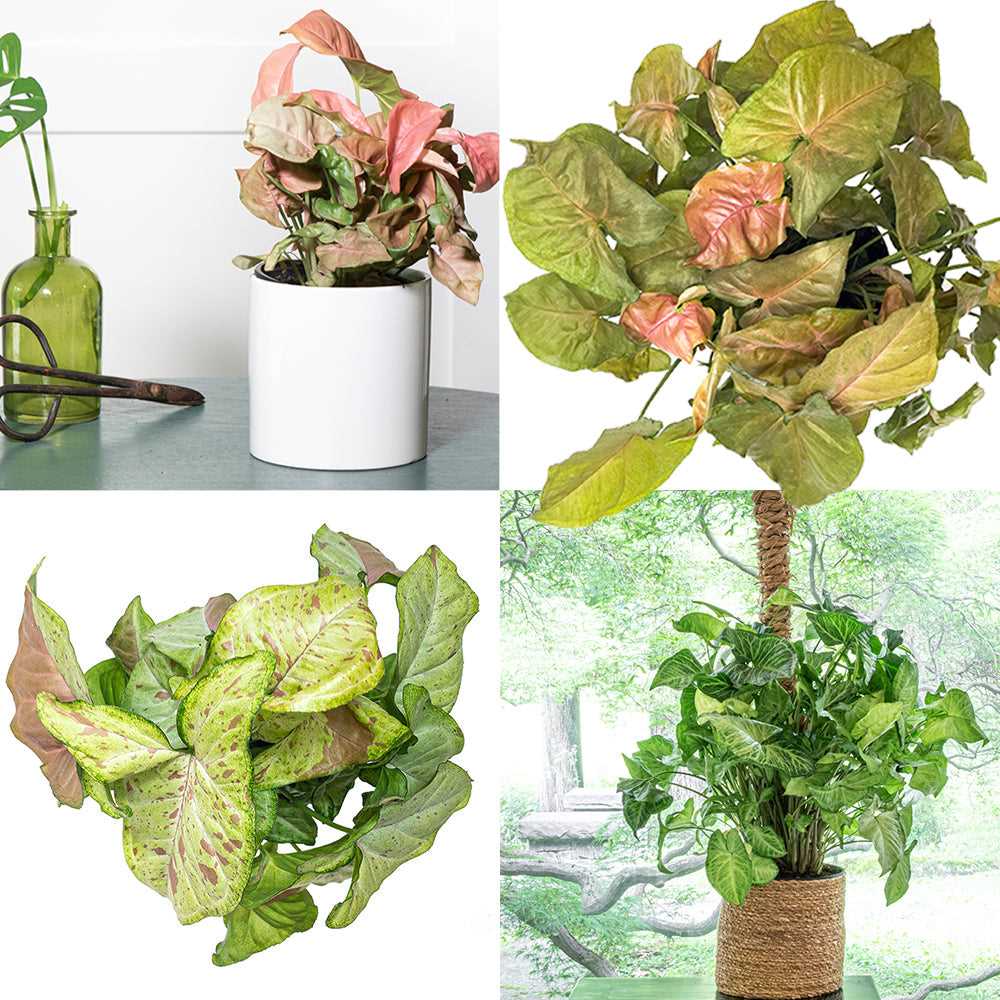- Syngonium Care at Home: Step-by-Step Guide
- 1. Lighting
- 2. Temperature
- 3. Watering
- 4. Humidity
- 5. Soil
- 6. Fertilizer
- 7. Pruning
- 8. Pests
- 9. Propagation
- 10. Toxicity
- Choosing the Right Type of Syngonium for Your Home
- Light Requirements:
- Size and Growth Habit:
- Foliage Colors and Patterns:
- Growing Difficulty:
- Allergenic Properties:
- Popular Syngonium Varieties: Aesthetic and Features
- 1. Syngonium podophyllum
- 2. Syngonium erythrophyllum
- 3. Syngonium wendlandii
- 4. Syngonium ‘Pink Splash’
- 5. Syngonium rayii
- 6. Syngonium ‘Pixie’
- 7. Syngonium macrophyllum
- Expert Tips for Syngonium Care
- 1. Lighting:
- 2. Temperature:
- 3. Watering:
- 4. Humidity:
- 5. Fertilization:
- 6. Pruning and Training:
- 7. Pest Control:
- 8. Propagation:
- 9. Repotting:
- 10. Common Issues:
- Common Problems with Syngonium and How to Solve Them
- 1. Yellowing or Browning Leaves
- 2. Pests
- 3. Curling Leaves
- 4. Leggy Growth
- 5. Stunted Growth
- Propagation Techniques for Syngonium: Tips from the Experts
- Cutting Propagation
- Division
- Air Layering
- Frequently Asked Questions about Syngonium Care
- 1. How often should I water my Syngonium plant?
- 2. What is the best location for my Syngonium plant?
- 3. How often should I fertilize my Syngonium plant?
- 4. Should I mist my Syngonium plant?
- 5. How do I propagate my Syngonium plant?
- Q&A:
- What are the types and varieties of Syngonium?
- How do I care for a Syngonium plant at home?
- Can I keep a Syngonium plant in a low-light area?
- How often should I water my Syngonium plant?
- Can I keep a Syngonium plant outdoors in a garden?
- What kind of soil is best for Syngonium plants?
- How do I propagate a Syngonium plant?
- Video: Simply Syngonium! | Everything you Need to Know about Arrowhead Vines
Syngonium, also known as Arrowhead plant or Goosefoot, is a popular choice among houseplant enthusiasts due to its stunning foliage and ease of care. This tropical plant is native to South America and belongs to the Araceae family. Syngonium comes in various shapes, colors, and sizes, making it a versatile and attractive addition to any indoor or outdoor space.
One of the key reasons why Syngonium is favored by many is its relatively low maintenance requirements. This plant thrives in well-draining soil and prefers moderate to bright indirect light. It can tolerate low light conditions, but the colors of the foliage may become less vibrant. Additionally, Syngonium appreciates high humidity levels and should be watered regularly, allowing the top inch of soil to dry out between waterings.
There are numerous types and varieties of Syngonium, each with its own unique characteristics. Some popular varieties include Syngonium podophyllum, Syngonium erythrophyllum, and Syngonium rayii. These plants can have variegated leaves in shades of green, white, pink, or red, adding a touch of elegance and whimsy to any space. Some varieties even display interesting patterns, such as speckles or veins, further enhancing their visual appeal.
If you’re considering adding a Syngonium to your plant collection, it’s important to note that these plants can also purify the air by removing toxins like formaldehyde, benzene, and trichloroethylene. Furthermore, Syngonium is relatively easy to propagate through stem cuttings, making it a suitable choice for plant enthusiasts who enjoy propagating their own plants. With proper care and attention, this beautiful plant can thrive and bring years of enjoyment to your home or garden.
Syngonium Care at Home: Step-by-Step Guide
Syngonium plants, also known as arrowhead plants, are popular houseplants because of their beautiful foliage and easy care requirements. Follow this step-by-step guide to provide proper care and ensure the healthy growth of your Syngonium plant at home.
1. Lighting
Syngonium plants prefer bright, indirect light. Place your plant near a window where it can receive filtered sunlight. Avoid exposing it to direct sunlight as it can lead to leaf burn.
2. Temperature

These plants thrive in temperatures between 60-85°F (15-29°C). Keep your Syngonium away from drafts and extreme temperature fluctuations.
3. Watering
Water your Syngonium plant when the top inch of soil feels dry. Avoid overwatering as it can cause root rot. Allow the water to drain completely from the pot after watering.
4. Humidity
Syngonium plants prefer high humidity levels. You can increase humidity by placing the pot on a tray filled with water and pebbles. Misting the leaves with water also helps maintain humidity.
5. Soil
Use well-draining potting soil for your Syngonium plant. A mixture of peat moss, perlite, and vermiculite works well. Ensure the pot has drainage holes to prevent waterlogging.
6. Fertilizer
Feed your Syngonium plant with a balanced, water-soluble fertilizer during the growing season (spring and summer). Follow the package instructions for proper dosage.
7. Pruning
Regular pruning helps maintain the desired shape and size of your Syngonium plant. Remove any yellow or brown leaves, as well as any leggy stems to encourage compact growth.
8. Pests

Keep an eye out for common houseplant pests like spider mites, mealybugs, and aphids. If you notice any signs of infestation, treat your plant with a mild insecticidal soap or neem oil.
9. Propagation
Syngonium plants can be easily propagated through stem cuttings. Take a 6-inch stem cutting with at least two leaves. Remove the lower leaves and place the cutting in a glass of water until roots develop. Then, plant it in a pot with well-draining soil.
10. Toxicity
Keep Syngonium plants away from children and pets as they can be toxic if ingested. The sap of the plant can cause skin irritation, so wear gloves while handling it.
| Common Problems | Solutions |
|---|---|
| Yellowing leaves | Check soil moisture levels and adjust watering accordingly. Ensure the plant is not getting direct sunlight. |
| Leggy growth | Prune back leggy stems to promote bushier growth. Provide adequate light for the plant. |
| Brown leaf tips | Increase humidity levels around the plant. Avoid over-fertilizing and ensure proper watering. |
By following these steps and providing proper care, your Syngonium plant will thrive and beautify your indoor space. Enjoy the lush foliage and unique patterns of this wonderful houseplant!
Choosing the Right Type of Syngonium for Your Home
Syngonium plants are popular for their attractive foliage and ease of care, making them a great choice for indoor gardening. However, with so many varieties and types available, it can be overwhelming to choose the right one for your home. Here are some factors to consider when selecting a Syngonium plant:
Light Requirements:
Syngonium plants thrive in medium to bright indirect light. Different varieties have different light requirements, so it’s essential to select a plant that matches the lighting conditions in your home. If you have a brightly lit room, go for varieties with more variegation, as they can handle more light. For lower light conditions, choose varieties with darker green leaves.
Size and Growth Habit:
Syngonium plants come in various sizes and growth habits. Some varieties stay compact and are ideal for small spaces or tabletops, while others grow long vines and are perfect for hanging baskets or trailing down shelves. Consider the available space in your home and choose a Syngonium plant that fits well and complements your interior style.
Foliage Colors and Patterns:
Syngonium plants have beautiful foliage with a wide range of colors and patterns. From variegated leaves with white or yellow stripes to solid green or even pink hues, there are countless options to choose from. Consider your preference and the color scheme of your home when selecting a Syngonium variety.
Growing Difficulty:
While Syngonium plants are generally easy to care for, some varieties may require more attention than others. If you are a beginner or have limited time to devote to plant care, opt for varieties that are known for their resilience and ability to tolerate occasional neglect.
Allergenic Properties:
It’s worth noting that Syngonium plants contain calcium oxalate crystals, which can cause skin irritation or discomfort if ingested. If you have children or pets at home, it’s advisable to choose non-toxic varieties or place the plant out of reach.
By considering these factors, you can select the right type of Syngonium plant that not only suits your home environment but also brings joy and beauty to your indoor space. Remember to research the specific care requirements for your chosen variety to ensure the plant’s long-term health and vitality.
Popular Syngonium Varieties: Aesthetic and Features
Syngonium plants come in a variety of different species and varieties, each with its own unique aesthetic and features. Here are some popular Syngonium varieties:
1. Syngonium podophyllum
Syngonium podophyllum, also known as arrowhead vine or goosefoot plant, is one of the most popular Syngonium varieties. It has arrow-shaped leaves that can come in various shades of green, white, or a combination of both. This variety is known for its fast growth rate and can be trained to climb up a trellis or cascade down from a hanging basket.
2. Syngonium erythrophyllum
Syngonium erythrophyllum is a rare Syngonium variety that is highly sought after by plant enthusiasts. It is known for its velvety, dark green leaves that have a reddish undertone. This variety prefers partial shade and high humidity.
3. Syngonium wendlandii
Syngonium wendlandii is a stunning Syngonium variety with large, heart-shaped leaves that have a beautiful silver veining. This variety is a climber and can be grown on a moss pole or allowed to cascade down from a hanging pot. It thrives in bright, indirect light and prefers regular watering.
4. Syngonium ‘Pink Splash’
Syngonium ‘Pink Splash’ is a popular Syngonium variety that is known for its eye-catching foliage. It has pink variegation on its leaves, giving it a unique and striking appearance. This variety is easy to care for and can tolerate a wide range of lighting conditions.
5. Syngonium rayii
Syngonium rayii is another rare Syngonium variety that is highly prized for its distinctive velvet-like leaves. It has a dark green color with silver veining, giving it a luxurious and elegant look. This variety prefers bright, indirect light and high humidity.
6. Syngonium ‘Pixie’
Syngonium ‘Pixie’ is a compact Syngonium variety that is perfect for small spaces or terrariums. It has small, arrow-shaped leaves that have a deep green color. This variety is low-maintenance and can tolerate lower light conditions.
7. Syngonium macrophyllum
Syngonium macrophyllum is a larger Syngonium variety that has long, lance-shaped leaves. It has a vibrant green color and can grow as a bushy plant, making it a great choice for adding greenery to any space.
These are just a few examples of the many beautiful and unique Syngonium varieties available. Each variety has its own specific care requirements, so be sure to research and understand the needs of your specific Syngonium plant to ensure its health and well-being.
Expert Tips for Syngonium Care
1. Lighting:
Syngonium plants prefer bright, indirect light. Avoid direct sunlight as it can scorch the leaves. Place your Syngonium near a north or east-facing window for optimal lighting conditions.
2. Temperature:
Syngoniums thrive in temperatures between 60-85°F (15-29°C). They are not frost-tolerant and can be sensitive to temperature fluctuations. Keep your Syngonium away from drafts and cold windows during winter months.
3. Watering:
Maintain well-draining soil for your Syngonium and water it regularly, keeping the soil moist but not soggy. Allow the top inch of soil to dry out before watering again. Overwatering can lead to root rot, so ensure proper drainage.
4. Humidity:

Syngoniums appreciate high humidity levels. If the air in your home is dry, you can increase humidity by placing a tray filled with water near the plant or using a humidifier. Misting the leaves occasionally also helps.
5. Fertilization:
Feed your Syngonium with a balanced houseplant fertilizer diluted to half strength every 2-4 weeks during the growing season (spring and summer). Reduce fertilization during winter when the plant is dormant.
6. Pruning and Training:

Regularly prune your Syngonium to maintain its shape and remove any dead or yellowing leaves. You can also train your Syngonium to climb or trail by using stakes or trellises. This encourages bushier growth and adds aesthetic appeal.
7. Pest Control:
Monitor your Syngonium for common houseplant pests such as spider mites, mealybugs, and aphids. If you notice any signs of pests, treat the plant with natural or chemical insecticides according to the product instructions.
8. Propagation:
Propagate your Syngonium through stem cuttings in water or well-draining soil. Place the cuttings in a warm and humid environment until they develop roots. Once rooted, transplant them into pots filled with a suitable potting mix.
9. Repotting:
Repot your Syngonium every 1-2 years, or when it outgrows its current pot. Choose a slightly larger pot with good drainage. Take care not to damage the plant’s delicate roots during the repotting process.
10. Common Issues:
- Yellow leaves: This can be caused by overwatering, too much direct sunlight, or nutrient deficiencies.
- Brown tips: Dry air, low humidity, or excessive fertilizer can lead to brown tips on the leaves.
- Pest infestation: Inspect your Syngonium regularly for signs of pests and treat promptly if necessary.
By following these expert tips, you can ensure healthy and thriving Syngonium plants in your home. Remember to observe your plant’s specific needs and adjust care accordingly.
Common Problems with Syngonium and How to Solve Them
1. Yellowing or Browning Leaves
One common problem with Syngonium plants is yellowing or browning leaves. This can be caused by overwatering or underwatering the plant. To solve this problem:
- Check the moisture level in the soil by sticking your finger about an inch deep into the soil. If it feels too dry, water the plant. If it feels too wet, reduce watering frequency.
- Ensure that the plant is not sitting in water-filled saucers or containers, as this can cause root rot.
- Make sure the plant is receiving adequate light. Too little light can also cause yellowing leaves.
- If the leaves are turning brown at the tips, it could be a sign of low humidity. Increase humidity by placing a tray of water near the plant or using a humidifier.
2. Pests
Syngonium plants can be susceptible to pest infestations, such as mealybugs, spider mites, and aphids. To address pest problems:
- Inspect the plant regularly to catch any pest infestations early on.
- If you notice pests, isolate the affected plant from other plants to prevent the infestation from spreading.
- Use a solution of neem oil or insecticidal soap to treat the infested plant. Follow the instructions on the product label for application.
- For severe infestations, you may need to repeat the treatment after a few weeks to ensure all pests are eliminated.
3. Curling Leaves
If the leaves of your Syngonium plant are curling, it could be a sign of low humidity or inadequate watering. Here’s how to address the issue:
- Increase humidity around the plant by misting the leaves with water or placing a humidifier nearby.
- Check the moisture level in the soil. Curling leaves can be a sign of underwatering. Make sure the soil is evenly moist and water the plant when the top inch of soil feels dry.
- Avoid placing the plant in direct sunlight, as this can also cause leaf curling. Provide bright, indirect light instead.
4. Leggy Growth
Syngonium plants are known for their bushy growth, but they can become leggy or spindly if they don’t receive enough light. To prevent leggy growth:
- Ensure that the plant is placed in a location that receives bright, indirect light.
- If the plant is not getting enough light, consider moving it closer to a window or providing supplemental grow lights.
- Regularly prune the plant to promote bushy growth. Pinching off the tips of the stems can encourage the plant to branch out.
5. Stunted Growth

If your Syngonium plant is not growing as quickly as expected, it may be due to several factors:
- Check the moisture level in the soil and adjust watering accordingly. Overwatering can lead to root rot and stunted growth.
- Make sure the plant is receiving enough light. Insufficient light can slow down growth. Consider moving the plant to a brighter location.
- Ensure that the plant is not root-bound. If the roots are overcrowded in the pot, repot the Syngonium into a larger container.
- Use a balanced fertilizer to provide the plant with essential nutrients for growth. Follow the recommended dosage on the fertilizer packaging.
Propagation Techniques for Syngonium: Tips from the Experts
Cutting Propagation
One popular method for propagating Syngonium is through stem cuttings. Here’s how you can do it:
- Select a healthy stem with at least 2-3 nodes.
- Cut the stem just below a node using a clean and sharp pair of scissors or pruning shears.
- Remove any leaves from the lower part of the cutting, leaving only a few leaves at the top.
- Place the cutting in a container filled with water or a well-draining potting mix.
- Keep the cutting in a warm and humid environment, away from direct sunlight.
- Change the water or moisten the potting mix regularly to ensure the cutting stays hydrated.
- After a few weeks, you should start to see roots developing. Once the roots are well-established, you can transfer the cutting into its own pot.
Division
Another propagation method for Syngonium is through division. This method is best suited for mature plants that have multiple stems or clumps. Here’s how to do it:
- Remove the plant from its pot and carefully separate the clumps into individual sections, ensuring each section has roots attached.
- Gently shake off excess soil from the roots.
- Plant each section in its own pot with well-draining potting mix.
- Water the newly potted sections thoroughly and place them in a warm and humid environment.
- Keep the soil moist but not waterlogged, and avoid direct sunlight.
- As the new plants grow, you can provide them with the same care as a mature Syngonium plant.
Air Layering
Air layering is an advanced propagation technique that can be used for Syngonium. Here’s how it works:
- Select a healthy stem and make a small incision near a node.
- Wrap the incision with moist sphagnum moss or peat moss, ensuring it is securely held in place with a plastic wrap or tin foil.
- Keep the moss moist by spraying it with water regularly.
- After a few weeks, roots should start to develop within the moss.
- Once the roots are well-established, you can cut the stem below the moss and pot it in a container filled with well-draining potting mix.
- Provide the newly potted plant with the appropriate care, including regular watering and indirect sunlight.
These propagation techniques can help you expand your Syngonium collection or share the joy of growing this beautiful plant with others. Each method has its own advantages, so feel free to experiment and find the one that works best for you!
Frequently Asked Questions about Syngonium Care
1. How often should I water my Syngonium plant?
It is important to keep the soil of your Syngonium plant evenly moist, but not overly wet. Watering once every 7-10 days should be sufficient. However, it is always best to check the soil moisture before watering by sticking your finger about an inch into the soil. If it feels dry at that depth, it’s time to water.
2. What is the best location for my Syngonium plant?
Syngonium plants thrive in bright, indirect light. Place your Syngonium plant near a window where it can receive dappled sunlight or place it a few feet away from a window with a sheer curtain to filter the sunlight. Avoid placing it in direct sunlight, as it can burn the leaves.
3. How often should I fertilize my Syngonium plant?
During the growing season (spring and summer), it is recommended to fertilize your Syngonium plant once a month. Use a balanced, water-soluble fertilizer and follow the instructions on the packaging for the correct dilution ratio. Do not fertilize during the dormant period in winter.
4. Should I mist my Syngonium plant?
While Syngonium plants appreciate high humidity, misting may not be necessary if the plant is placed in a naturally humid environment. However, if the air in your home is dry, misting the leaves of your Syngonium plant once a week can help increase the humidity around it.
5. How do I propagate my Syngonium plant?

Syngonium plants can be propagated through stem cuttings or division. To propagate through stem cuttings, take a 4-6 inch cutting from a healthy mature plant and place it in a glass of water or directly into a container with moist potting soil. Keep the cutting in a warm and humid environment until roots develop. To propagate through division, carefully separate the plant into smaller sections, ensuring each section has roots attached.
Q&A:
What are the types and varieties of Syngonium?
Syngonium plants come in a variety of types and varieties. Some popular types include Syngonium podophyllum, Syngonium neon, Syngonium erythrophyllum, and Syngonium angustatum. Each type has its own unique characteristics and appearance.
How do I care for a Syngonium plant at home?
Caring for a Syngonium plant at home involves providing it with the right amount of light, water, and humidity. They prefer bright, indirect light and moderate watering. It is also important to keep the humidity levels high by misting the leaves regularly or placing the plant on a tray of water.
Can I keep a Syngonium plant in a low-light area?
While Syngonium plants prefer bright, indirect light, they can tolerate low-light areas to some extent. However, they may not grow as vigorously or have vibrant foliage in such conditions. If you plan to keep a Syngonium plant in a low-light area, make sure to provide it with occasional bright light and monitor its growth closely.
How often should I water my Syngonium plant?
Syngonium plants like to be kept evenly moist but not soaked. You can water them whenever the top inch of soil feels dry to the touch. It is important not to overwater or let the plant sit in waterlogged soil, as this can lead to root rot.
Can I keep a Syngonium plant outdoors in a garden?
Syngonium plants are tropical in nature and prefer warm and humid conditions, so they can be kept outdoors in a garden if the climate is suitable. However, they should be protected from direct sunlight and cold drafts. It is also important to bring them indoors during colder months or if the weather becomes too harsh.
What kind of soil is best for Syngonium plants?
Syngonium plants prefer a well-draining potting mix that retains some moisture. A mix of peat moss, perlite, and a small amount of potting soil or compost can work well for them. It is important to avoid using heavy or compacted soil, as it can lead to waterlogging and root rot.
How do I propagate a Syngonium plant?
Syngonium plants can be easily propagated through stem cuttings. Simply cut a healthy stem below a node and place it in a glass of water or moist soil. Keep the cutting in a warm and bright area, and roots should start to develop within a few weeks. Once the roots are well established, the cutting can be transferred to a pot with soil.
Video:
Simply Syngonium! | Everything you Need to Know about Arrowhead Vines








